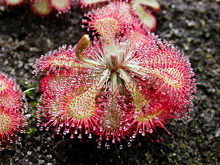| Drosera | |
|---|---|

| |
| Drosera tokaiensis | |
| Scientific classification | |
| Kingdom: | Plantae |
| Clade: | Tracheophytes |
| Clade: | Angiosperms |
| Clade: | Eudicots |
| Order: | Caryophyllales |
| Family: | Droseraceae |
| Genus: | Drosera L. |
| Subgenera | |
| Synonyms[1] | |
| |
Drosera, which is commonly known as the sundews, is one of the largest genera of carnivorous plants, with at least 194 species.[2] These members of the family Droseraceae[1] lure, capture, and digest insects using stalked mucilaginous glands covering their leaf surfaces. The insects are used to supplement the poor mineral nutrition of the soil in which the plants grow. Various species, which vary greatly in size and form, are native to every continent except Antarctica.[3]
Charles Darwin performed much of the early research into Drosera, engaging in a long series of experiments with Drosera rotundifolia which were the first to confirm carnivory in plants.[4][5][6] In an 1860 letter, Darwin wrote, “…at the present moment, I care more about Drosera than the origin of all the species in the world.”[7]
- ^ a b "Drosera L." Plants of the World Online. Royal Botanic Gardens, Kew. 2023. Retrieved 13 January 2023.
- ^ McPherson, S.R. (2010). Carnivorous Plants and their Habitats. Poole, England, UK: Redfern Natural History Productions Ltd. 2 volumes.
- ^ McPherson, S.R. (2008). Glistening Carnivores. Poole, England, UK: Redfern Natural History Productions Ltd.
- ^ Pain, Stephanie (2 March 2022). "How plants turned predator". Knowable Magazine. doi:10.1146/knowable-030122-1. Retrieved 11 March 2022.
- ^ Hedrich, Rainer; Fukushima, Kenji (17 June 2021). "On the Origin of Carnivory: Molecular Physiology and Evolution of Plants on an Animal Diet". Annual Review of Plant Biology. 72 (1): 133–153. doi:10.1146/annurev-arplant-080620-010429. ISSN 1543-5008. PMID 33434053. S2CID 231595236.
- ^ Cite error: The named reference
Darwin-1875was invoked but never defined (see the help page). - ^ Ellison, Aaron M.; Gotelli, Nicholas J. (1 January 2009). "Energetics and the evolution of carnivorous plants—Darwin's 'most wonderful plants in the world'". Journal of Experimental Botany. 60 (1): 19–42. doi:10.1093/jxb/ern179. ISSN 0022-0957. PMID 19213724.